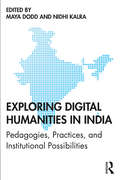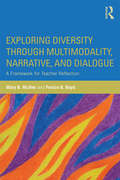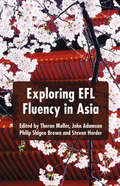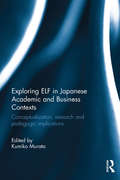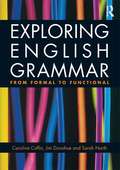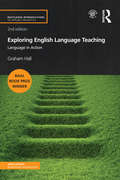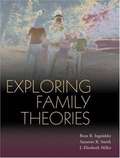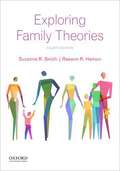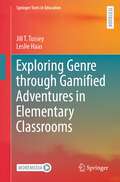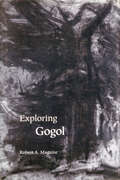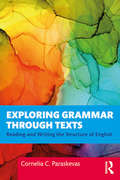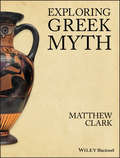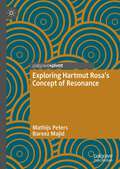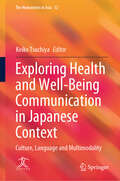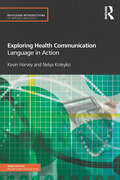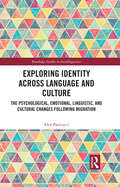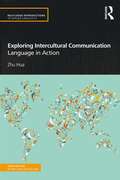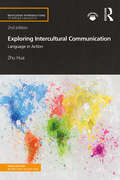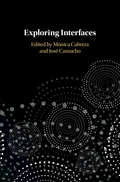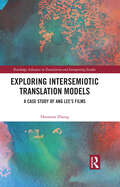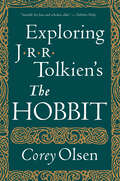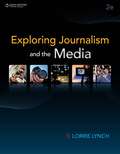- Table View
- List View
Exploring Digital Humanities in India: Pedagogies, Practices, and Institutional Possibilities
by Maya Dodd Nidhi KalraThis book explores the emergence of digital humanities in the Indian context. It looks at how online and digital resources have transformed classroom and research practices. It examines some fundamental questions: What is digital humanities? Who is a digital humanist? What is its place in the Indian context? The chapters in the volume: • study the varied practices and pedagogies involved in incorporating the ‘digital’ into traditional classrooms; • showcase how researchers across disciplinary lines are expanding their scope of research, by adding a ‘digital’ component to update their curriculum to contemporary times; • highlight how this has also created opportunities for researchers to push the boundaries of their pedagogy and encouraged students to create ‘live projects’ with the aid of digital platforms; and • track changes in the language of research, documentation, archiving and reproduction as new conversations are opening up across Indian languages. A major intervention in the social sciences and humanities, this book will be of great interest to scholars and researchers of media studies, especially new and digital media, education, South Asian studies and cultural studies.
Exploring Discourse in Context and in Action
by Christopher N. Candlin Jonathan Crichton Stephen H. MooreThis book combines an authoritative examination of the field of discourse-based research with practical guidance on research design and development. The book is not prescriptive but instead invites expansive, innovative thinking about what discourse is, why it matters to people at particular sites and how it can be investigated. The authors identify a set of questions that, they argue, are crucial for understanding discourse. Part I of the book explores the implications of these questions, providing a comprehensive survey of relevant scholars, theories, concepts and methodologies. Part II addresses these implications, setting out a multi-perspectival approach to resourcing and integrating micro and macro perspectives in the description, interpretation and explanation of data. Part III offers wide-ranging resources to support further reflection and future research. Ultimately, this book offers a new research approach for students, researchers and practitioners in Applied Linguistics to encourage and support research that can be truly impactful through its relevance to social and professional practice.
Exploring Diversity through Multimodality, Narrative, and Dialogue: A Framework for Teacher Reflection
by Mary B. McVee Fenice B. BoydExploring Diversity through Multimodality, Narrative, and Dialogue awakens educators to the ways in which values, beliefs, language use, culture, identity, social class, race, and other factors filter approaches to teaching and expectations for students. Designed as a guide to help educators engage in dialogic interactions, the text articulates a theoretically grounded and research-based framework related to the use of personal narratives as learning tools. Educators are encouraged to consider their own positions, explore topics of diversity and social justice, and identify ways to better address student needs. Drawing on theories from multiliteracies, multimodality, embodiment, and narrative, chapters are framed around book discussions and the use of personal narrative to define and provide examples of dialogic interactions. Unique to this book is its focus on embodied learning and multimodality as well as myriad artifacts produced by educators; listening, not just dialogic talk; writing (both traditional print texts and multimodal composition) that supports dialogic interaction; and not merely responding to literature but developing empathic responses to texts, students, and others whose opinions may differ from one’s own viewpoints. The specific techniques and approaches presented can be used within educational and professional development settings to help readers enhance their journey toward greater awareness of others and of their own beliefs and experiences that lead toward social justice for all.
Exploring EFL Fluency in Asia
by Theron Muller John Adamson Philip Shigeo Brown Steven HerderIn EFL contexts, an absence of chances to develop fluency in the language classroom can lead to marked limitations in English proficiency. This volume explores fluency development from a number of different perspectives, investigating measurements and classroom strategies for promoting its development.
Exploring ELF in Japanese Academic and Business Contexts: Conceptualisation, research and pedagogic implications
by Kumiko MurataThis book investigates the theoretical, empirical and pedagogical issues to help us better understand what is happening with English as a Lingua Franca (ELF) communication and to activate this knowledge in respective communicative contexts. It focuses specifically on Japanese contexts and also includes theoretical and practical sections pertinent to all ELF researchers, practitioners and students, irrespective of their national or regional differences. It further attempts to connect this new field of research to established fields of linguistics and applied linguistics such as communication, assessment and multilingualism by exploring them from an ELF perspective, which is challenging but essential for the development of the field. Exploring ELF in Japanese Academic and Business Contexts: Conceptualisation, research and pedagogic implications includes chapters about: English in a Global Context Own-language use in academic discourse English as a lingua franca in international business contexts A linguistic soundscape/landscape analysis of ELF information provision in public transport in Tokyo Using pragmatic strategies for effective ELF communication: Relevance to classroom practice This book will be of interest to scholars and post-graduate students working in the fields of Applied Linguistics/TESOL. It will also engage researchers studying the growing influence of English around the world.
Exploring English Grammar: From formal to functional
by Caroline Coffin Sarah North Jim DonohueThis engaging textbook bridges the gap between traditional and functional grammar. Starting with a traditional approach, students will develop a firm grasp of traditional tools for analysis and learn how SFG (Systemic Functional Grammar) can be used to enrich the traditional formal approach. Using a problem-solving approach, readers explore how grammatical structures function in different contexts by using a wide variety of thought-provoking and motivating texts including advertisements, cartoons, phone calls and chatroom dialogue. Each chapter focuses on a real world issue or problem that can be investigated linguistically, such as "mis"-translation or problems arising from a communication disorder. By working on these problems, students will become equipped to understand and analyze formal and functional grammar in different genres and styles. With usable and accessible activities throughout, Exploring English Grammar is ideal for upper undergraduate and postgraduate students of English language and linguistics.
Exploring English Language Teaching: Language in Action (Routledge Introductions to Applied Linguistics)
by Graham HallRoutledge Introductions to Applied Linguistics is a series of introductory level textbooks covering the core topics in Applied Linguistics, primarily designed for those entering postgraduate studies and language professionals returning to academic study. The books take an innovative ‘practice to theory’ approach, with a ‘back-to-front’ structure. This leads the reader from real-world problems and issues, through a discussion of intervention and how to engage with these concerns, before finally relating these practical issues to theoretical foundations. Additional features include tasks with commentaries, a glossary of key terms, and an annotated further reading section. Exploring English Language Teaching provides a single volume introduction to the field of ELT from an applied linguistics perspective. The book addresses four central themes within English language teaching: ‘Classroom interaction and management’; ‘Method, Postmethod and methodology’; ‘Learners’; and the ‘Institutional frameworks and social contexts’ of ELT. For each, the book identifies key dilemmas and practices, examines how teachers and other language teaching professionals might intervene and deal with these concerns, and explores how such issues link to and inform applied linguistic theory. This second edition has been extensively revised and updated to explore the latest practical developments and theoretical insights in the field of ELT. With new material, including expanded discussions of CLIL, the role of new technologies in ELT, and the teaching of large classes in difficult circumstances, and with an updated glossary and suggestions for additional reading, this is an indispensable textbook for language teachers and students studying in the areas of Applied Linguistics, Language Teacher Education, and ELT/TESOL.
Exploring Family Theories
by Bron B. IngoldsbyThe purpose of this text is to provide a basic introduction to the major theories pertaining to the family among professionals today. Each addresses different aspects of family life and answers different questions. Humans are extremely complex, and it is difficult to analyze ourselves; therefore, every theory will be imperfect. But each one brings us closer to understanding and being able to make positive change where needed in family life. Each theory has its own basic assumptions and concepts, and is a product of its own historical context as well. Each is used in answering specific research questions that other theories may not answer, or may answer differently. It will be up to you to try on the lens of each theory and determine how well you think it explains human and family behavior.
Exploring Family Theories
by Suzanne R. Smith Raeann R. HamonOffering a diverse variety of perspectives, Exploring Family Theories, Fourth Edition, is a combined text/reader that integrates theory with research and applications. In each chapter, Suzanne R. Smith and Raeann R. Hamon present the history, scholarship, and critiques of one principal family theory in a concise manner. Numerous examples and illustrations augment and clarify content, while application questions help students relate these theories to the real world. After each chapter, a follow-up journal article exemplifies how that particular theory is used to guide actual research.
Exploring Genre through Gamified Adventures in Elementary Classrooms (Springer Texts in Education)
by Jill T. Tussey Leslie HaasThis book provides real-world examples of incorporating gamified learning into elementary school classrooms. Scaffolded by relevant research on gamification, literacy, and pedagogy support, this book focuses on how to seamlessly integrate and gamify literacy instruction in a fun, engaging, and unique way. Each chapter is tied to a specific genre, supported by national standards, and represented through developed lesson plans. The gamified activities and tasks provide a framework for meeting standards-based learning objectives. Chapters consist of: · genre specific adventure quests to guide students through lessons; · project-based activities focused on art, listening, speaking, and writing; · anchor texts and text sets centered on the chapter’s theme; · material lists, resource materials, and graphic images to support understanding; · teaching tips and differentiation strategies to support novice and career teachers alike. This book is aimed at preservice teachers, university faculty, practicing teachers, instructional coaches, and administrative instructional leaders.
Exploring Gogol
by Robert MaguireFor the past 150 years, critics have referred to 'the Gogol problem', by which they mean their inability to account for a life and work that are puzzling, often opaque, yet have proved consistently fascinating to generations of readers. This book proceeds on the assumption that Gogol's life and work, in all their manifestations, form a whole; it identifies, in ways that have eluded critics to date, the rhetorical strategies and thematic patterns that create the unity. These larger concerns emerge from a close study of the major texts, fictional and nonfictional, and in turn are set in a broad artistic and intellectual context, Russian and European, with special attention to German philosophy, the visual arts, and Orthodox Christian theology.
Exploring Grammar Through Texts: Reading and Writing the Structure of English
by Cornelia ParaskevasThis textbook provides an innovative introduction to core areas of grammar: a systematic guide to the structure of English, arranged hierarchically from the word to the sentence to the paragraph level. Using a linguistic framework, activities and exercises, and diverse authentic texts, the book connects grammar knowledge to writing development, strengthening student understanding of language as a tool for text construction. Students of linguistics and English language will develop foundational knowledge about grammar and texts, as will writing students. Aligning with state curricular standards around the world, the book will be particularly useful for students of English Education.
Exploring Greek Myth (Coursesmart Ser.)
by Matthew ClarkExploring Greek Myth offers an extensive discussion of variant forms of myths and lesser-known stories, including important local myths and local versions of PanHellenic myths. Clark also discusses approaches to understanding myths, allowing students to gain an appreciation of the variety in one volume. Guides students from an introductory understanding of myths to a wide-ranging exploration of current scholarly approaches on mythology as a social practice and as an expression of thought Written in an informal conversational style appealing to students by an experienced lecturer in the field Offers extensive discussion of variant forms of myths and many lesser known, but deserving, stories Investigates a variety of approaches to the study of myth including: the sources of our knowledge of Greek myth, myth and ritual in ancient Greek society, comparative myth, myth and gender, hero cult, psychological interpretation of myth, and myth and philosophy Includes suggestions in each chapter for essays and research projects, as well as extensive lists of books and articles for further reading The author draws on the work of many leading scholars in the field in his exploration of topics throughout the text
Exploring Hartmut Rosa's Concept of Resonance
by Mathijs Peters Bareez MajidThis book makes a compelling case for utilising experiences of resonance in various academic and societal fields. The concept of resonance was first introduced by Hartmut Rosa to foreground the importance of affective, emotional, transformative and uncontrollable experiences in socio-political contexts that he characterizes as alienating. Based on a critical reading of Rosa’s theory and further developed through engagement with Theodor W. Adorno, Gilles Deleuze, Hannah Arendt, Judith Butler and others, this book introduces the notion of a ‘spectrum of resonance’ which encompasses both critical resonance and affirmationist resonance. This spectrum of resonance is used to analyse various forms of aesthetic experience illustrated with reference to Edgar Reitz’s film Heimat and the music of Nick Cave and Kayhan Kalhor. The spectrum is also deployed in the fields of museum, memory and trauma studies to show how experiences of resonance contribute to the constitution of political and social identities. The focus here is on memory practices in the Kurdistan Region of Iraq and the book seeks to decolonize resonance theory.
Exploring Health and Well-Being Communication in Japanese Context: Culture, Language and Multimodality (The Humanities in Asia #12)
by Keiko TsuchiyaThis book is a selection of linguistic and multimodal research on healthcare and well-being communication in Japan. This volume offers unique perspectives to the field of healthcare communication research, where studies in the West is still dominant, providing a missing piece of the whole picture. Multiculturality and multimodality in interactions in healthcare and well-being are the themes in this volume. Culture here is not limited to ethnic groups, including any sociocultural groups from different professional disciplines to atypical individuals. Two research principles are addressed: (1) multiculturality: how are inter/cross-cultural encounters or issues among different sociocultural groups addressed, and what practices are embodied in a particular sociocultural setting?, and (2) multimodality: what semiotic resources are included in the analysis, how are those data collected and transcribed? The first chapter (Tsuchiya) provides a concise overview of healthcare communication research in Japan and Europe, introducing the themes and chapters in this volume. The introductory chapter is followed by case studies in a range of research fields in healthcare and well-being in Japan: Chapter 2 (Aizaki) employs a discourse analytic approach to examine framing in a first-encounter interaction among a Japanese adult with ASD and other three non-ASD Japanese adults. The context of Nukuto's ethnographic discourse research (Chapter 3) was set in a classroom at a Japanese university, where a special education teacher was teaching crafting (monodukuri) to prospective teachers, highlighting materials as a communicative medium for grounding. Chapter 4 (Sekine, Takashima, Oka, Yano, and Suzuki) investigates how Deaf children who use Japanese Sign Language adjust their expressions of a special location in interactions with those in different age groups. Chapter 5 (Yohena) analyses discourses in Christian coaching between an American coach and a Japanese client from a cross-cultural perspective. The last two chapters are studies in hospital. Kuroshima's conversation analytic research (Chapter 6) provides a detailed description of doctors' use of patient's medical records during consultations. Chapter 7 (Tsuchiya, Nakamura and Coffey) captures a moment when a trauma team leader rejects a member's proposal in simulation in the UK and Japan. The concluding chapter (Chapter 8, Tsuchiya) recapitulates themes, theories and methods which the chapter authors employed in the previous chapters, encouraging publications in health and well-being communication research in Asia and beyond.
Exploring Health Communication: Language in Action (Routledge Introductions to Applied Linguistics)
by Kevin Harvey Nelya KoteykoRoutledge Introductions to Applied Linguistics is a series of introductory level textbooks covering the core topics in Applied Linguistics, primarily designed for those beginning postgraduate studies, or taking an introductory MA course as well as advanced undergraduates. Titles in the series are also ideal for language professionals returning to academic study. The books take an innovative ‘practice to theory’ approach, with a 'back-to-front' structure. This leads the reader from real-world problems and issues, through a discussion of intervention and how to engage with these concerns, before finally relating these practical issues to theoretical foundations. Additional features include tasks with commentaries, a glossary of key terms, and an annotated further reading section. Exploring Health Communication brings together many of the various linguistic strands in health communication, while maintaining an interdisciplinary focus on method and theory. It critically explores and discusses a number of underlying themes that constitute the broad field of health communication including spoken, written and electronic health communication. The rise of the internet has led to an explosion of interactive online health resources which have profoundly affected the way in which healthcare is delivered, and with this, have brought about changes in the relationship between provider and patient. This textbook uses examples of real life health language data throughout, in order to fully explore the topics covered. Exploring Health Communication is essential reading for postgraduate and upper undergraduate students of applied linguistics and health communication.
Exploring Identity Across Language and Culture: The Psychological, Emotional, Linguistic, and Cultural Changes Following Migration (Routledge Studies in Sociolinguistics)
by Alex PanicacciThis book explores the ways in which migrants’ experience in today’s multilingual and multicultural society informs language use and processing, behavioural patterns, and perceptions of self-identity. Drawing on survey data from hundreds of Italian migrants living in English- speaking countries, in conjunction with more focused interviews, this volume unpacks reciprocal influences between linguistic, cultural, and psychological variables to shed light on how migrants emotionally engage with the local and heritage dimensions across public and private spaces. Visualising the impact of a constant shifting of linguistic and cultural practices can enhance our understanding of migration experiences, foreign language acquisition, language processing and socialisation, inclusion, integration, social dynamics, acculturation tendencies, and cross-cultural communication patterns. Overall, this book appeals to students and scholars interested in gaining nuanced insights into the linguistic, cultural, and psychological underpinnings of migration experiences in such disciplines as sociolinguistics, cultural studies, and social psychology.
Exploring Identity Across Language and Culture: The Psychological, Emotional, Linguistic, and Cultural Changes Following Migration (Routledge Studies in Sociolinguistics)
by Alex PanicacciThis book explores the ways in which migrants’ experience in today’s multilingual and multicultural society informs language use and processing, behavioural patterns, and perceptions of self-identity.Drawing on survey data from hundreds of Italian migrants living in English- speaking countries, in conjunction with more focused interviews, this volume unpacks reciprocal influences between linguistic, cultural, and psychological variables to shed light on how migrants emotionally engage with the local and heritage dimensions across public and private spaces. Visualising the impact of a constant shifting of linguistic and cultural practices can enhance our understanding of migration experiences, foreign language acquisition, language processing and socialisation, inclusion, integration, social dynamics, acculturation tendencies, and cross-cultural communication patterns.Overall, this book appeals to students and scholars interested in gaining nuanced insights into the linguistic, cultural, and psychological underpinnings of migration experiences in such disciplines as sociolinguistics, cultural studies, and social psychology.
Exploring Intercultural Communication: Language in Action
by Zhu HuaRoutledge Introductions to Applied Linguistics is a series of introductory level textbooks covering the core topics in Applied Linguistics, primarily designed for those beginning postgraduate studies, or taking an introductory MA course as well as advanced undergraduates. Titles in the series are also ideal for language professionals returning to academic study. The books take an innovative 'practice to theory' approach, with a 'back-to-front' structure. This leads the reader from real-world problems and issues, through a discussion of intervention and how to engage with these concerns, before finally relating these practical issues to theoretical foundations. Additional features include tasks with commentaries, a glossary of key terms, and an annotated further reading section. Exploring Intercultural Communication investigates the role of language in intercultural communication, paying particular attention to the interplay between cultural diversity and language practice. This book brings together current or emerging strands and themes in the field by examining how intercultural communication permeates our everyday life, what we can do to achieve effective and appropriate intercultural communication, and why we study language, culture and identity together. The focus is on interactions between people from various cultural and linguistic backgrounds, and regards intercultural communication as a process of negotiating meaning, cultural identities, and – above all – differences between ourselves and others. Including global examples from a range of genres, this book is an essential read for students taking language and intercultural communication modules within Applied Linguistics, TESOL, Education or Communication Studies courses.
Exploring Intercultural Communication: Language in Action (Routledge Introductions to Applied Linguistics)
by Zhu HuaExploring Intercultural Communication investigates the role of language in intercultural communication, paying particular attention to the interplay between cultural diversity and language practice. This second edition increases and updates the coverage on emerging key topics, including symbolic power, communicative turbulence, conversational inequality, stereotypes, racism, Nationality and Ethnicity talk and the impact and role of technology in intercultural communication. Including global examples from a range of genres, this book is an indispensable resource for students taking language and intercultural communication modules within applied linguistics, TESOL, education or communication studies courses.
Exploring Interfaces
by Mónica Cabrera José CamachoModels of theoretical linguistics now emphasize the meeting points, or interfaces, between different aspects of our language capacity. Syntactic operations include structure-building, checking long-distance relationships between units, and connecting alternative word orders. This volume presents a collection of original studies that explore the mapping between these operations and other language-related areas such as word meanings, discourse contexts, the construction of meaning for larger units, and the alternative expressions of word order. It differs from previous traditional research on interfaces by bringing together studies and analyses from a range of languages, using monolingual varieties that include second language phenomena. Case studies of different types of interfaces, as well as studies based on lesser known sets of linguistic data, provide important examples that propose a new view of the connections between syntactic processes and other areas of grammar.
Exploring Intersemiotic Translation Models: A Case Study of Ang Lee's Films (Routledge Advances in Translation and Interpreting Studies)
by Haoxuan ZhangThis volume sets out a new paradigm in intersemiotic translation research, drawing on the films of Ang Lee to problematize the notion of films as the simple binary of transmission between the verbal and non-verbal. The book surveys existing research as a jumping-off point from which to consider the role of audiovisual dimensions, going beyond the focus on the verbal as understood in Jakobsonian intersemiotic translation. The volume outlines a methodology comprising a system of various models which draw on both translation studies and film studies frameworks, with each model illustrated with examples from Ang Lee’s Crouching Tiger, Hidden Dragon; Lust, Caution; and Life of Pi. In situating the discussion within the work of a director whose own work straddles East and West and remediates between cultures and semiotic systems, Zhang argues for an understanding of intersemiotic translation in which films are not simply determined by verbal source material but through the process of intersemiotic translators mediating non-verbal, quality-determining materials into the final film. The volume looks ahead to implications for translation and film research more broadly as well as other audiovisual media. This book will appeal to scholars interested in translation studies, film studies, media studies and cultural studies in general.
Exploring J.r.r. Tolkien's "the Hobbit"
by Corey OlsenExploring J.R.R. Tolkien’s The Hobbit is an in-depth look at one of the most beloved books of the twentieth century, uncovering its secrets and delights. “An admirable and thought-provoking consideration of the underlying themes of The Hobbit, following the there-and-back-again progress from its famous first line on through to Bilbo's return home at the story's end.” —Douglas A. Anderson, author of The Annotated HobbitA fun, thoughtful, and insightful companion volume designed to bring a thorough and original new reading of this great work to a general audience, Tolkien scholar Corey Olsen takes readers on a thorough journey through The Hobbit chapter by chapter, revealing the stories within the story: the dark desires of dwarves and the sublime laughter of elves, the nature of evil and its hopelessness, the mystery of divine providence and human choice, and, most of all, the transformation within the life of Bilbo Baggins. Exploring J.R.R. Tolkien’s The Hobbit is a book that will make the classic fantasy story come alive for readers as never before.“Worthy of your tightly guarded dragon’s treasure. . . . Indispensable.” —Boston Globe“Sharing Corey Olsen’s personal view of The Hobbit is like having a long conversation with someone who shares the love of a favorite book and is excited to talk about it. His exploration of the journey of Bilbo Baggins will encourage readers to think more deeply about Tolkien’s classic tale.” —Wayne G. Hammond and Christina Scull, authors of The Art of The Hobbit by J. R. R. Tolkien
Exploring Journalism and the Media
by Lorrie LynchIntroduce your students to the exciting world of journalism using the hands-on, relevant approach of EXPLORING JOURNALISM AND THE MEDIA, 2e. The instructional model presents timeless concepts and applications that will prepare students for scholastic journalism, as well as lay the ground work for future classes, jobs, and careers. Author Lorrie Lynch's experience as a USA Today journalist gives a unique perspective absent from most other journalism textbooks. Profiles of real journalists, authentic student writings from scholastic publications, 21st Century Career Skills, and discussion on legal issues and editorial ethics will help students connect to the curriculum. EXPLORING JOURNALISM AND THE MEDIA, 2e will not only introduce students to the many different journalism career opportunities, but will also help them perform better in the classroom by providing academic connections, grammar tips, critical thinking activities, and writing activities.
Exploring Journalism and the Media
by Lorrie LynchIntroduce your students to the exciting world of journalism using the hands-on, relevant approach of EXPLORING JOURNALISM AND THE MEDIA, 2e. The instructional model presents timeless concepts and applications that will prepare students for scholastic journalism, as well as lay the ground work for future classes, jobs, and careers. Author Lorrie Lynch's experience as a USA Today journalist gives a unique perspective absent from most other journalism textbooks. Profiles of real journalists, authentic student writings from scholastic publications, 21st Century Career Skills, and discussion on legal issues and editorial ethics will help students connect to the curriculum. EXPLORING JOURNALISM AND THE MEDIA, 2e will not only introduce students to the many different journalism career opportunities, but will also help them perform better in the classroom by providing academic connections, grammar tips, critical thinking activities, and writing activities.
